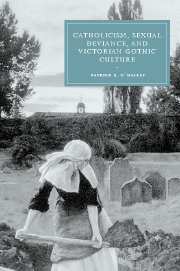Book contents
- Frontmatter
- Contents
- List of illustrations
- Acknowledgments
- Introduction: skeletons in the cloister
- 1 Goths and Romans: the literature of Gothic from Radcliffe to Ruskin
- 2 “The Church's closet”: Victorian Catholicism and the crisis of interpretation
- 3 Domestic Gothic: unveiling Lady Audley's Secret
- 4 The blood of the saints: vampirism from Polidori to Stoker
- 5 “Monstrous and terrible delight”: the aesthetic Gothic of Pater and Wilde
- 6 Conclusions: Oxford's ghosts and the end of the Gothic
- Notes
- Works cited
- Index
- CAMBRIDGE STUDIES IN NINETEENTH-CENTURY LITERATURE AND CULTURE
Introduction: skeletons in the cloister
Published online by Cambridge University Press: 06 July 2010
- Frontmatter
- Contents
- List of illustrations
- Acknowledgments
- Introduction: skeletons in the cloister
- 1 Goths and Romans: the literature of Gothic from Radcliffe to Ruskin
- 2 “The Church's closet”: Victorian Catholicism and the crisis of interpretation
- 3 Domestic Gothic: unveiling Lady Audley's Secret
- 4 The blood of the saints: vampirism from Polidori to Stoker
- 5 “Monstrous and terrible delight”: the aesthetic Gothic of Pater and Wilde
- 6 Conclusions: Oxford's ghosts and the end of the Gothic
- Notes
- Works cited
- Index
- CAMBRIDGE STUDIES IN NINETEENTH-CENTURY LITERATURE AND CULTURE
Summary
There are few of us who have not sometimes wakened before dawn, either after one of those dreamless nights that make us almost enamoured of death, or one of those nights of horror and misshapen joy, when through the chambers of the brain sweep phantoms more terrible than reality itself, and instinct with that vivid life that lurks in all grotesques, and that lends to Gothic art its enduring vitality, this art being, one might fancy, especially the art of those whose minds have been troubled with the malady of reverie.
Oscar Wilde, The Picture of Dorian Gray (1891)In 1859 John Everett Millais exhibited at the Royal Academy a painting entitled The Vale of Rest, which portrayed a young nun digging a grave while another sits to the side, staring frankly – even immodestly – at the viewer. Images of death fill the painting. The digging nun stands in an open grave while her companion sits on a gravestone; other crooked gravestones – and, beyond them, a darkened wall – surround them. A “coffin-shaped cloud” hangs in the darkening sky above a fading autumn sunset; at the bottom right corner of the painting, two funeral wreaths lie withering over each other, mimicking the position of wedding bands, and the supervising nun's rosary includes a small skull. Contemporary critics were not, in general, positively disposed to the subject matter of the painting, though several praised its technique.
- Type
- Chapter
- Information
- Publisher: Cambridge University PressPrint publication year: 2006



